This post may contain affiliate links at no additional cost to you. As an Amazon Associate I earn from qualifying purchases. Click to view our full disclosure.
What's inside
If you are looking for the best high calorie and low carb foods, you’ve come to the right place.
As a Registered Dietitian, I understand the struggles of finding foods that can increase your daily calories without depleting your carb budget. That’s why I created this detailed guide.
But why is this necessary?
There are several popular reasons why you might need to consume high-calorie and low-carb foods. For example, you might be following a keto diet or be an athlete with a strict macro budget.
Whatever the reason might be, keep reading to find out the best 25 healthy high-calorie and low-carb foods you should include.
What are high calorie and low carb foods?
Related: 15 Best High Calorie Breakfast Ideas
Before we talk about the best high-calorie and low-carb foods, we need to understand that there is no set definition.
However, based on my years of experience coaching people, I consider a high calorie food to be one that has more than 125 calories per 100 grams. This means it is going to provide 1.25 calories per gram.
To be considered low in carbs, it should have less than 20 g of net carbs (net carbs = total carbs – fiber).
So, a high-calorie, low-carb food should have more than 125 calories per 100 g with less than 20 g of carbs.
Benefits of Eating High Calorie Low Carb Foods
Related: 1500 Calorie Meal Plan PDF
Here’s how this type of diet can help.
- It can control blood sugar levels.
- Can make it easier to reach your caloric intake.
- Might reduce the risk of type 2 diabetes.
- It may promote weight loss (as long as you are in a caloric deficit).
- It can increase ketone production.
Who should eat high-calorie low-carb foods?
Related: 1300 Calorie Meal Plan PDF
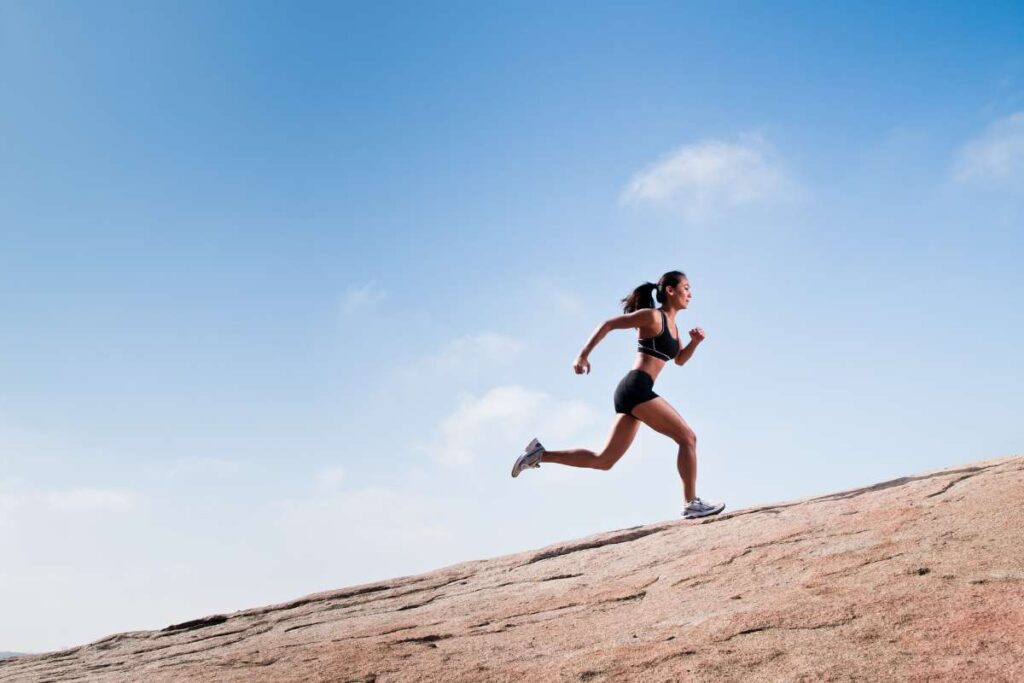
People following a keto diet or people with diabetes can highly benefit from these foods.
Athletes can also benefit from consuming high-calorie and low-carb foods. Athletes can require very high caloric intakes (3,000 to 4,000 calories).
The same applies for people who are on a caloric surplus (eating more calories than the body needs) to gain muscle mass.
As someone who struggles to reach her caloric intake, I can assure you that these foods make it easier to follow a high-calorie meal plan.
How Many Calories and Carbs You Need Per Day
Related: 2100 Calorie Meal Plan PDF
A meal plan should always be personalized.
How many calories and carbs you need is based on your age, weight, height, activity levels, and goals.
A health professional can help you determine how many calories and carbs you need. However, if you are unable to see a health professional, you can always use our free calorie and macro calculator to help you establish your calories and macros.
The High-Calorie, Low-Carb Food List
Related: Best 12 Week Carb Cycling Meal Plan For Fat Loss (With PDF)
Protein Sources
- Whole Eggs
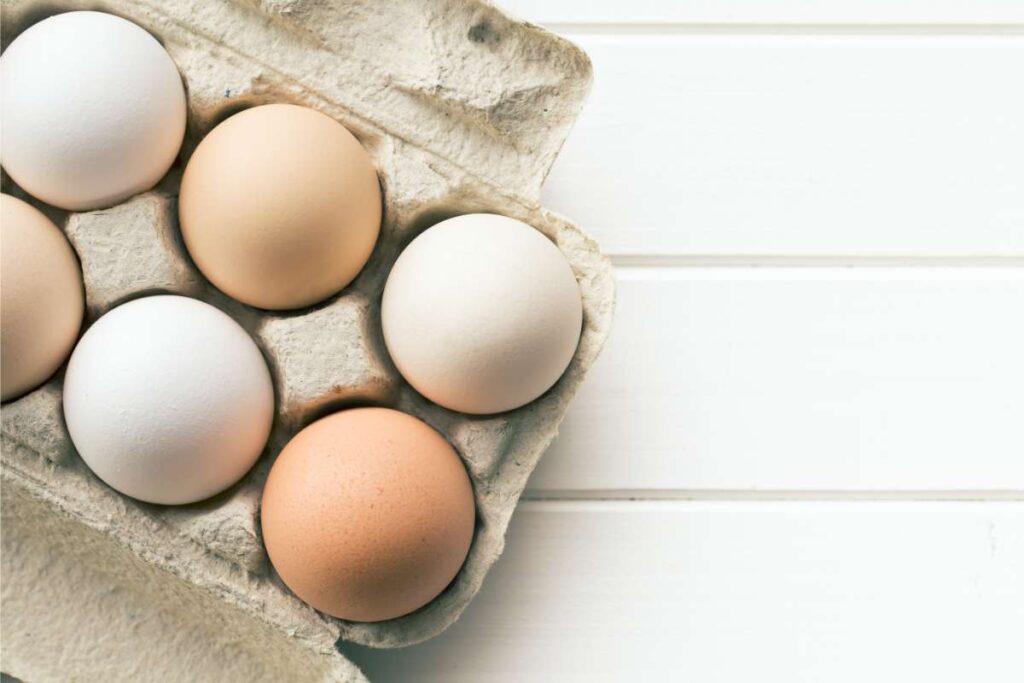
Starting first on the list we have whole eggs. Per 100 g of raw eggs:
- Calories: 143
- Net carbs: 0.7 g
- Protein: 12.6 g
- Fats: 9.5 g
Whole eggs are high in nutrients. They contain essential vitamins and minerals like vitamins B12, A, B2, and selenium.
They are one of the best protein sources since they contain all the essential amino acids the body needs.
Keep in mind that if you remove the egg yolk, you are giving up on healthy fats and calories. Now, while it is ideal for those trying to lose weight, it is not the best for those looking to add calories to their diet.
To add more calories to your scrambled eggs, try adding olive oil and parmesan cheese. I can assure you you’ll love your breakfast time!
- Beef loin
Beef contains no carbs and all the calories come from protein and fat. In 100 g of raw beef loin you get:
- Calories: 149
- Net carbs: 0.0 g
- Proteins: 22.8 g
- Fats: 6.4 g
Now, not every beef cut is going to be high in calories. There are lean options that are going to be better for those looking to cut back on their calories.
So, if you are looking to increase your calorie intake, make sure you choose a fattier cut.
To balance the dish without adding too many carbs, make sure you add a source of non-starchy vegetables like broccoli, asparagus, cauliflower, peppers, or onions.
- Ground Pork
Another high-quality protein that is going to help you add calories is ground pork. In 100 g of ground pork you get:
- Calories: 218
- Net carbs: 0.4 g
- Proteins: 18.0 g
- Fats: 16.0 g
Pork usually tends to have a bad rep. But just like beef, there are different cuts to choose from. If you are looking for a high-calorie option, choose pork that is 84% lean.
Another benefit of pork is that it is rich in heme-iron. This type of iron is found in red meats and is easily absorbed by our digestive system.
To boost your iron intake, make sure you pair it with a food higher in vitamin C like red bell peppers.
- Lamb
Moving along in the list, we have another protein source that is going to boost your calorie intake without affecting your carbs. In 100 g of lamb, you get:
- Calories: 193
- Net carbs: 0.0 g
- Proteins: 20.3 g
- Fats: 12.4 g
Besides being a high-quality protein. It is also a good source of vitamins and minerals like vitamin B12, selenium, iron, zinc, and niacin.
Additionally, lamb is set to be high in conjugated linoleic acid (CLA) which seems to have possible health benefits such as reduced fat mass.
- Salmon

When it comes to nutrition, you can’t quite beat salmon. Salmon is full of omega-3 fatty acids which helps reduce inflammation, lowers the risks of chronic diseases, and supports brain health.
In 100 g of salmon you get:
- Calories: 142
- Net carbs: 0.0 g
- Proteins: 19.8 g
- Fats: 6.3 g
Salmon is an extremely versatile food and easy to prepare on the grill, in the oven, pan-seared, or steamed. It is also popular raw and served in sushi and sashimi.
When possible, try to choose wild-caught over farmed-raised since it is going to be higher in nutrients and better quality.
- Tuna salad
Remember that you can always combine foods to make them high in calories.
And, there is no better combination than Tuna salad.
Tuna salad is simple to make, portable, and very high in calories. The amount of calories it has depends on the ingredients used. However, on average, it has tuna, mayo, celery, red onion, parsley, and Dijon mustard.
In 100 g of tuna salad you get:
- Calories: 187
- Net carbs: 9.4 g
- Proteins: 16.0 g
- Fats: 9.3 g
To add more calories, you can add a couple of slices of avocado on the side.
- Chicken thighs with skin
Chicken thighs have become very popular these days. They are moist, tasty, and less expensive than chicken breasts.
In 100 g of chicken thighs, you get:
- Calories: 197
- Net carbs: 0.0 g
- Proteins: 16.6 g
- Fats: 14.6 g
Keep in mind that most of the calories and fat come from the chicken skin. So, if you end up removing it, you might not get as many calories as you need.
However, the fat found in the skin is saturated, a bad fat. High consumption of saturated fats might lead to an increased risk of heart disease. Be careful with the consumption of saturated fats like chicken skin throughout the week.
- Bacon
The final protein you can include that will boost your calorie content is bacon. In 100 g of bacon you get:
- Calories: 501
- Net carbs: 2.1 g
- Proteins: 40.9 g
- Fats: 36.5 g
Now, while bacon can be a great way to increase your calories, its high saturated fat content means you should be careful with how much you add throughout the week.
Also, bacon can be high in sodium, which can increase the risk of high blood pressure.
Fats
- Extra Virgin Olive Oil
Since extra virgin olive oil is minimally processed, it retains the most nutrients and antioxidants. Antioxidants protect our cells against free radicals, which are produced when our body breaks down food or is exposed to radiation or tobacco.
Too many free radicals in the body can lead to an increase in inflammation and increased risk of chronic illnesses.
In 100 g of extra virgin olive oil you get:
- Calories: 800
- Net carbs: 0.0 g
- Proteins: 0.0 g
- Fats: 93.3 g
Choose extra virgin olive oil for raw preparations, like salad dressing. Choose regular olive oil for cooking since it has a higher smoking point.
- Avocado Oil
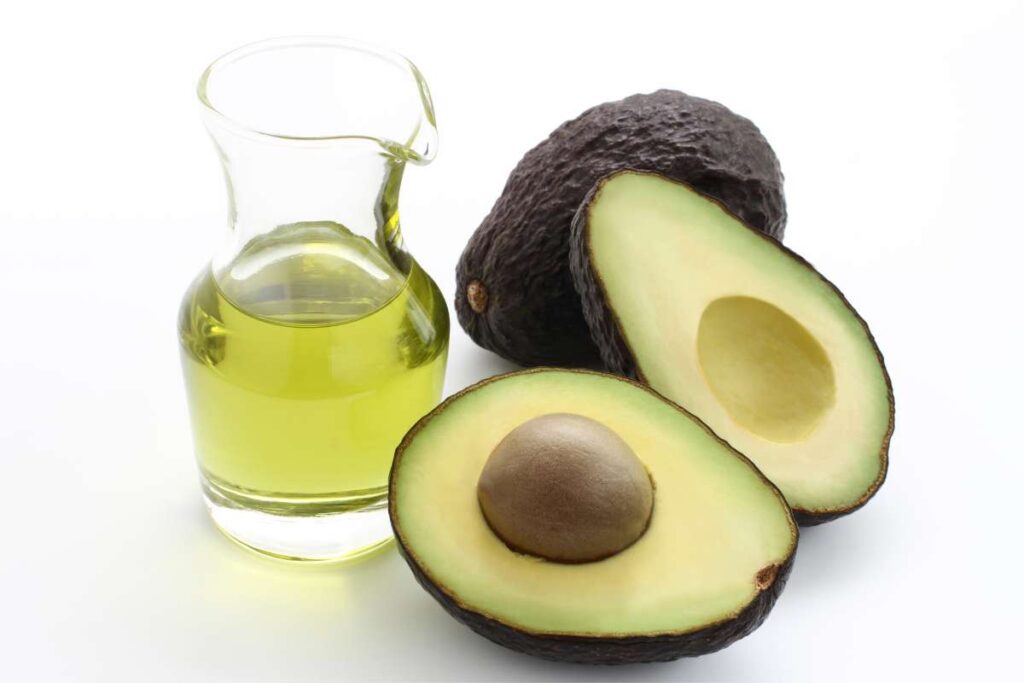
Just like olive oil, avocado oil is high in antioxidants and good fat that help reduce inflammation.
In 100 g of avocado oil you get:
- Calories: 884
- Net carbs: 0.0 g
- Proteins: 0.0 g
- Fats: 100.0 g
One of the biggest benefits of avocado oil is its lutein content. Lutein is a carotenoid found in the eyes. So, consuming avocado oil might help maintain eye health.
- Avocado
While you might think that avocado oil and avocado have the same composition, they don’t. They are pretty similar, but not exactly the same.
Still, they are both high in calories.
In 100 g of avocado, you get:
- Calories: 160
- Net carbs: 1.8 g
- Proteins: 2.0 g
- Fats: 14.7 g
One of the benefits of avocado is its high fiber content. In 100 g, you find 27% of the daily recommended value of fiber. A high fiber content can help promote good gut health and good bowel movements.
- Coconut milk
Moving along in the best healthy high-calorie and low-carb foods we have coconut milk. In 100 g of coconut milk, we get:
- Calories: 230
- Net carbs: 3.3 g
- Proteins: 2.3 g
- Fats: 23.8 g
As you can see, if you are looking for a dairy alternative that is going to help you pile on the calories, coconut milk is the way to go.
While coconut milk is a good option, other foods like shredded coconut might be a bit higher in carbs. And, while it doesn’t make them bad, you need to count them towards your total carb intake.
- Coconut oil
Coconut oil is high in calories and low in carbs. In 100 g of coconut oil you get:
- Calories: 895
- Net carbs: 0.8 g
- Proteins: 0.0 g
- Fats: 99.1 g
What makes coconut oil one of the best oils to include is its high MCT content. Medium chain triglycerides (MCT), can increase ketone content which can promote weight loss and increase fullness levels.
- Olives
Whether you choose green or black, olives are a great option high in calories and low in carbs. In 100 g of olives, you get:
- Calories: 141
- Net carbs: 1.0 g
- Proteins: 1.2 g
- Fats: 12.9 g
When choosing olives, be careful with the sodium content. A high sodium consumption (more than 2,300 mg per day), can increase the risk of heart disease, such as high blood pressure.
Choose olives that have less than 200 mg of sodium per serving. Ideally, they should have less than 150 mg.
- Dark chocolate

For those looking for something sweet, dark chocolate can be a great way to increase the calories without adding too many carbs. However, not all dark chocolate is going to fit this description.
In 100 g of 90% sugar-free dark chocolate, you get:
- Calories: 594
- Net carbs: 18.8 g
- Proteins: 9.4 g
- Fats: 50.0 g
As you can see, the ideal dark chocolate that won’t increase your carb intake is made from 90% chocolate and with sugar-free alternatives. While you can choose other options, they have high calories plus a higher carb content.
- Mayo
The last fat you can include to increase your calories without affecting your carb intake is mayo. In 100 g of mayo you get:
- Calories: 594
- Net carbs: 18.8 g
- Proteins: 9.4 g
- Fats: 50.0 g
Make sure you get full-fat mayo. If you get the fat-free version, you are going to get less calories and more carbs.
Dairy
- Cheese
Who doesn’t love cheese? Whether it is part of happy hour paired with wine on a charcuterie board or eaten as part of an omelet, it’s a winner.
Aged cheese is typically high in calories and low in carbs. Options like cheddar, Swiss, and parmesan are all great options.
Each cheese has its unique nutritional value, but for reference, let’s talk about cheddar cheese. In 100 g of cheddar cheese you get:
- Calories: 410
- Net carbs: 2.1 g
- Proteins: 24.2 g
- Fats: 33.8 g
If you choose a low-fat option like cottage or feta, it might be a good protein source but might not provide as many calories as you need.
- Ghee
Ghee is clarified butter. This means that most of the solids are removed, producing a pure product. As a result, you get a higher nutritional value and lower lactose content.
In 100 g of ghee you get:
- Calories: 900
- Net carbs: 0.0 g
- Proteins: 0.0 g
- Fats: 100.0 g
Ghee has a creamier and cheesier flavor. It pairs nicely with both sweet or savory dishes.
If you cannot find ghee at your local store, create a similar version by melting butter. Once all the butter is melted, remove the solid particles on top (clarification). Then, place the clear liquid in another container and put it in the fridge.
- Cream cheese
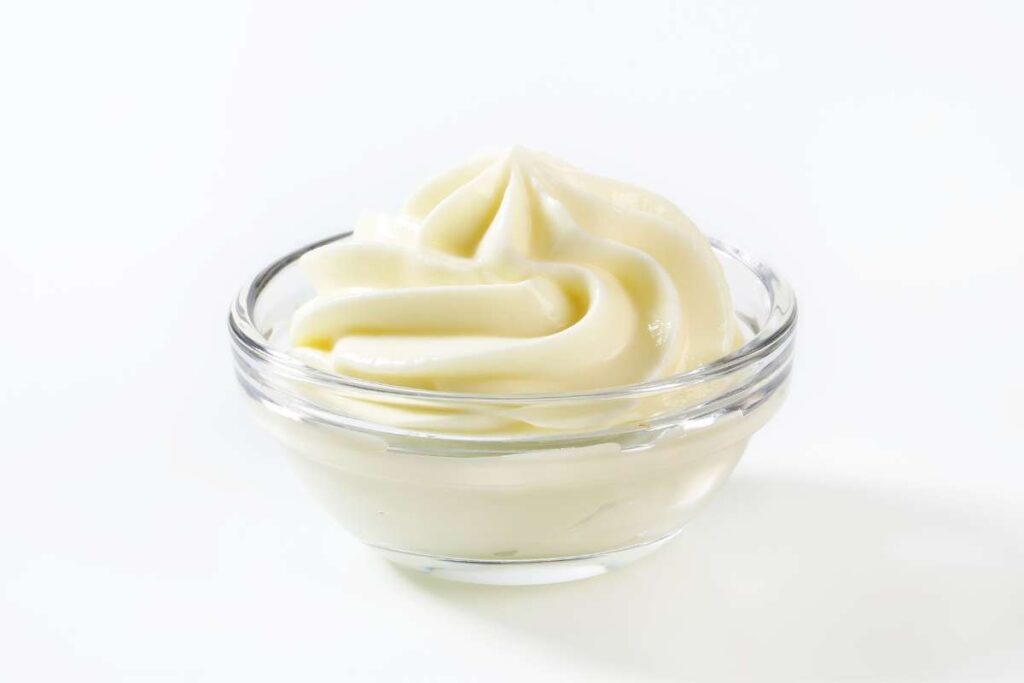
Cream cheese is a soft cheese with a high fat content. While most people think cream cheese is a good protein source, the truth is that it is actually higher in fat than protein.
In 100 g of cream cheese you get:
- Calories: 350
- Net carbs: 5.5 g
- Proteins: 6.2 g
- Fats: 34.4 g
Just like mayo, if you want a high-calorie, low-carb option make sure you go with the regular cream cheese. If you choose low-fat cream cheese it can be lower in calories and higher in carbs.
- Heavy cream
The final dairy product that is high in calories and low in carbs is heavy cream. In 100 g of heavy cream, you get:
- Calories: 343
- Net carbs: 3.8 g
- Proteins: 2.0 g
- Fats: 35.6 g
Heavy cream is great to make ice cream. Blend some heavy cream with some berries and a sugar-free alternative like stevia or Monk fruit. You’ll get a high-calorie, low-carb sweet and refreshing treat for the summer.
Nuts and Seeds
- Nuts
Nuts like almonds, walnuts, peanuts, cashews, and Brazil nuts are high in calories and low in carbs. While they might vary in the nutritional composition, they are pretty similar.
They are all high in antioxidants and healthy fats, helping reduce inflammation.
To give you an idea of the nutrition information of nuts, in 100 g of almonds, you get:
- Calories: 626
- Net carbs: 10.8 g
- Proteins: 21.4 g
- Fats: 51.1 g
Besides being low in carbs, they are a good source of plant-based protein, making it an ideal option for those on a vegetarian or vegan diet.
- Nut butter
Peanut butter, almond butter, or cashew butter are great foods to add to your favorite smoothie to increase your calorie intake.
One of the benefits of them, especially peanuts, is that they are high in protein, helping support muscle mass and boost your overall protein intake.
In 100 g of peanut butter you get:
- Calories: 632
- Net carbs: 16.4 g
- Proteins: 24.0 g
- Fats: 49.4 g
One of the benefits of nut butters is their versatility. As mentioned before, you can add them to your smoothie, but you can also can some celery sticks, apple slices, or make a salad dressing with them.
- Chia Seeds
Chia seeds are not only high in nutrients like omega-3 and calcium, but they are also extremely high in fiber. This makes them an ideal option for those fighting with constipation.
In 100 g of chia seeds you get:
- Calories: 486
- Net carbs: 7.7 g
- Proteins: 16.5 g
- Fats: 30.7 g
One tablespoon of chia seeds provides almost 40% of the recommended daily intake for fiber. So, if you are having trouble with bowel movements, add one tablespoon of chia seeds to a glass of warm lemon water. I can assure you that it will fix everything!
- Pumpkin Seeds
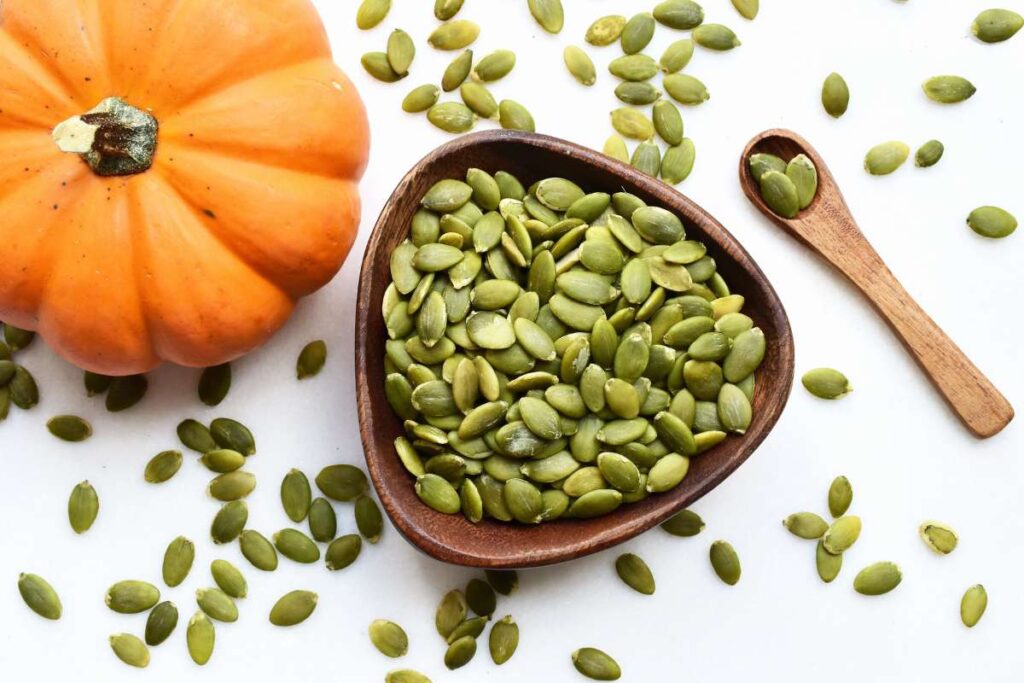
Pumpkin seeds are portable and delicious. In 100 g of pumpkin seeds, you get:
- Calories: 574
- Net carbs: 8.2 g
- Proteins: 29.8 g
- Fats: 49.0 g
If you don’t want to eat pumpkin seeds raw, you can always place them in the oven or air-fryer. Drizzle some olive oil on them and add some herbs before you roast them.
Now you have a crunchy and delicious high-calorie and low-carb snack.
- Hemp seeds
The last food high in calories and low in carbs are hemp seeds. In 100 g of hemp seeds you get:
- Calories: 553
- Net carbs: 4.7 g
- Proteins: 31.6 g
- Fats: 48.8 g
What makes hemp seeds such an amazing option is their high omega-3 content. As seen, omega-3 can help reduce inflammation and improve heart health.
Try sprinkling some hemp seeds on top of your favorite salad to add a crunchy element.
The Bottom Line
We’ve made it through the best 25 healthy high-calorie, low-carb foods for training and weight loss.
Foods high in protein, healthy fats, or both are a great combination to provide fuel for training and to help you feel full and satisfied.
Keep in mind, nutrient balance is important when fueling your body properly for training. To personalize your nutrition, contact a Registered Dietitian to discuss the best plan for you.
Did you learn something new? What were your takeaways? Let us know in the comments.
Frequently Asked Questions
How can I increase my calories without carbs?
Add high-protein and high-fat foods. Options like nuts, seeds, avocado, and oils are the best foods to add if you want to increase your calories without adding too many carbs.
How can I gain weight with less carbs?
Include high-calorie foods with a low carb content such as avocado, oils, nuts, seeds, and fatty fish like salmon. This can make it easier to reach a caloric surplus (eating more calories than you need) to help you gain weight.
How many calories do I need to gain weight?
Add 200 to 300 calories to your maintenance calories to help you gain weight. Always have a caloric surplus with an appropriate exercise program to ensure the weight gain is mostly muscle mass.
If you don’t know how many calories you need, you can use our calorie and macro calculator.
What foods have the most calories to gain weight?
High-fat foods like oil, butter, nuts, and seeds are very high in calories. On average, per 100 g they can provide 400 to 500 calories.
Do you need carbs to build muscle?
While protein is the most important nutrient when it comes to muscle building, carbs also play an essential role since they help improve recovery and replace glycogen stores.
Even though you can still gain muscle while doing keto, it is easier to gain muscle with a higher carb intake.
What fruit has the most calories?
Medjool dates are one of the highest calorie fruits. In 100 g of medjool dates, you get 277 calories. But, keep in mind that they are also high in carbs.

